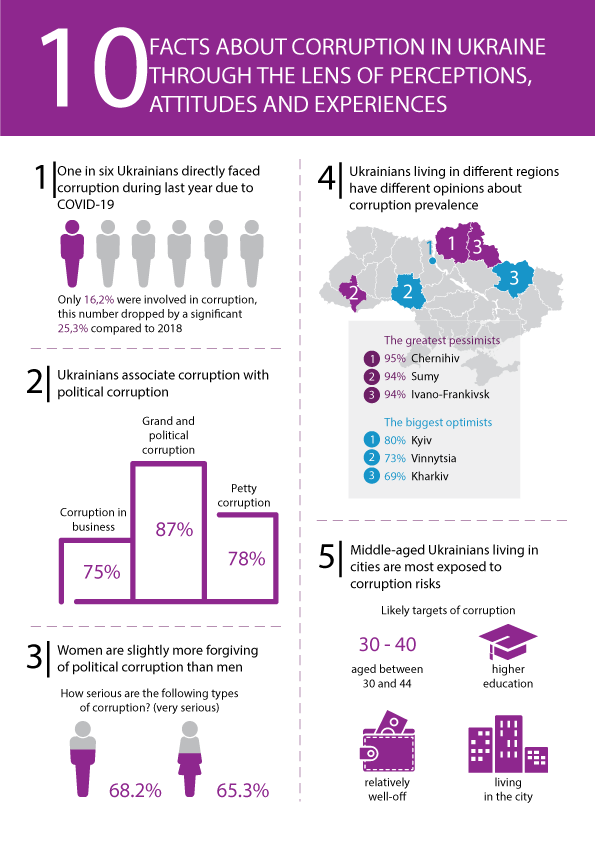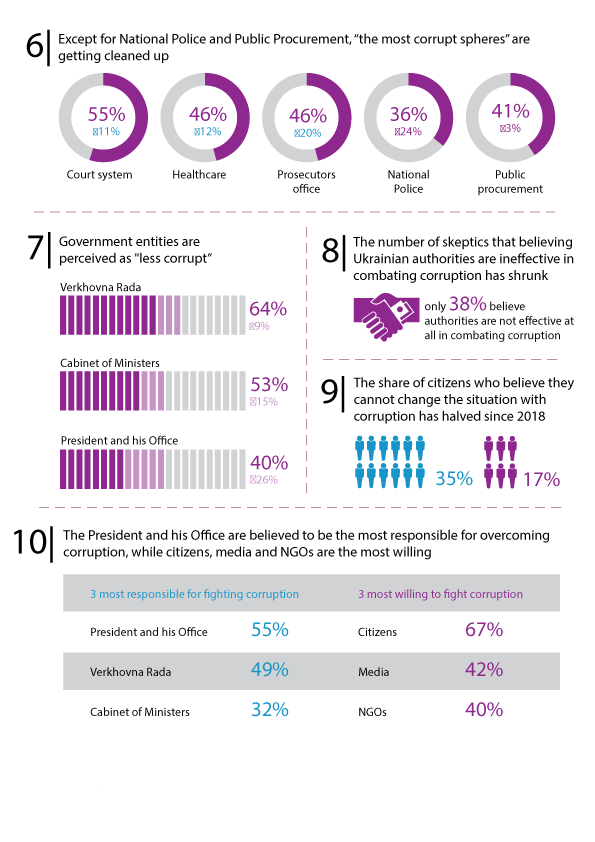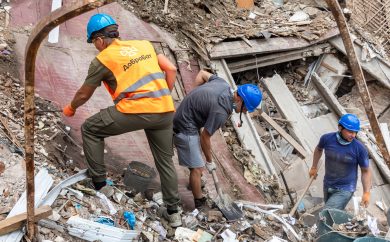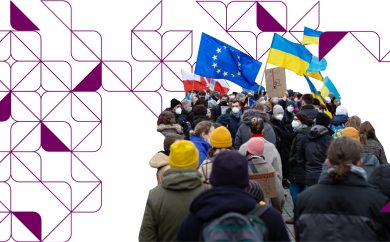Anticorruption policy analysts and reform champions are in a data-privileged situation as far as Ukraine is concerned. The March 2021 edition of the Anticorruption Perception and Experience poll continues the fifteen-year journey of monitoring corruption and anticorruption reform in Ukraine. The first study in this series was done in 2007. It was then followed up in 2009, 2011, 2015 and 2018. This enormous pool of data allows national authorities, foreign partners, and civil society actors to trace how Ukrainians think, feel and experience corruption in everyday life and through narratives that are dominant in the society. Here we present only some of the most impressive insights of the poll’s 2021 edition and compare them with the previous measurements done in 2018 and 2015 to provide a more comprehensive longitudinal view. The Kyiv International Institute of Sociology completed the field stage of the 10’000-respondent poll commissioned by USAID/ENGAGE in late February 2021. As such, the most evident data analysis disclaimer is that the ongoing pandemic and its restrictions have impacted citizen perceptions and real-life experiences. The poll’s respondents included the adult population (aged 18 years or older) from all oblasts and the city of Kyiv. The temporarily occupied territories of the Autonomous Republic of Crimea, city of Sevastopol, and certain areas of Donetsk and Luhansk oblasts outside the control of the government of Ukraine, were excluded from the 2015-2021 surveys. The questionnaire was administered in face-to-face interviews, and respondents were selected to shape a multistage random sample with quota selection at the last stage. With 10 011 respondents, the data is representative for the whole population of Ukraine, including at the level of oblasts. The statistical margin of error (with probability of 0,95 and design-effect of 1,5) is less or equal to 1,5% for results nearing 50%; 1,3% for results close to 25% or 75%; 1,0% for results close to 12% or 88%; 0,6% for results close to 5% or 95% and, finally, 0,3% for results that near 1% or 99%.
Main findings
To have a deeper and more comprehensive look at the situation in Ukraine, we would have to consider the dynamics beyond the comparison of 2018 and 2021. Instead, it is important to include 2015 as the year for more informed conclusions, where possible. Both 2015 and 2021 are years when hopes of Ukrainians for change and transformation were high. In many senses, the 2018 data is an outlier in the fifteen-year set with wide-ranging pessimism and societal apathy. This ought to be considered, when interpreting the data. Meanwhile, if we were to briefly summarize the most important findings from the 2021 survey, we would need to note the following:
- 2021 data suggest that corruption has moved to become the number one concern for the country. It is tempting to say that corruption has increased in importance for Ukrainians as compared to 2018 and 2015. This statement is not entirely correct, though. Respondents have provided a consistent rating for corruption in 2015, 2018 and 2021 (94.4% in 2015, 93.7% in 2018 and 93.5% in 2021). This year, corruption made it to the top of the list due to the perceived reduced importance of “high cost of living and low salaries” and “military conflict in Donetsk and Luhansk oblasts”. Moreover, other polls suggest that inclusion of “COVID-19” as an option into the overall list, results in a different set of preferences. In the USAID / ENGAGE poll, roughly equal shares of women and men indicated that corruption was an extremely serious challenge (74.9% women, 75.6% men). The younger generation (18-29) had the lowest degree of apprehension regarding the corruption problem (70.6% believed it to be a very serious issue) and the oldest respondent quartile (aged 60+) was the most pessimistic of all (76.8% of such respondents noted that corruption was of much concern).
- When asked to choose the most detrimental types of corruption (political, petty, or business), respondents decidedly leaned towards “grand and political corruption” being the greatest evil. 87,2% of the respondents pointed out to this type of corruption as the most corrosive (combined “very serious” and “serious” responses). Women seem to be slightly more forgiving of political corruption than men, as 65.3% women and 68.2% men in 2021 believe this to be an extremely serious challenge. With regards to petty corruption, there is no gender difference in shares of women and men who considered it to be a very serious issue (49.9% for both sexes). Respondents of older age (60+), from the rural areas, and those with elementary or some secondary education are amongst the champions of decrying both political and petty corruption.
- Citizen experience with corruption decreased in 2021. Fewer Ukrainians faced extortion in 2021 compared to 2018 (19.4% vs 36.8%) and used their personal connections (12.5 % vs 17%) while offering bribes slightly increased from 11.6% in 2018 to 14.6% in 2021. Multiple reasons may be sought for overall decrease in personal experience with corruption, and not one of them is able to explain the entire phenomenon. Throughout 2020 and early 2021, Ukrainians have had fewer contacts with authorities due to the pandemic particularly with those that are more prone to corruption. For example, contacts between citizens and representatives of healthcare system decreased form 64% to 55%. Similar reduction in contacts was with schools and social service providers. Another possible factor of reduction in personal experience with corruption is the growth of administrative service centers and electronic services (for instance, the “Diia” portal and application) that minimize direct contacts and discretion in administrative service delivery. In 2021, young men (age up to 45) in urban areas faced extortion more frequently than other demographic groups. There is no significant difference across all demographic groups with regard to offering bribes. Men in urban areas of age 30-44 years slightly more frequently used personnel connections. Extortion was more frequent in Odesa, Sumy, Kharkiv and Kirovograd oblasts while citizens of Chernihiv and Mykolayiv reported extortion the least frequently. Odesa, Kharkiv and Donetsk oblasts are high on offering bribes and Kharkiv, Kirovograd and Ivano-Frankivsk are high on citizens using their connections in dealing with public officials. Extortion, although reduced in 2021, remained the highest in schools, healthcare and the higher education systems. Voluntary bribery remained the highest in the school system. Overall, bribery and the use of personal connections increased in many other sectors and functions particularly in government subsidized housing and public procurement.
- In parallel to reporting fewer cases of facing corruption directly, Ukrainians are increasingly noting that corruption shall not be justified, even in cases where it is key to solving an important personal problem. Thus, since 2015, the number of citizens noting they believe that corruption is in most cases justified has dropped from 19,1% (2015) through 14,3% (2018) to 13,0% in 2021. The share of Ukrainians who believe that corruption is never justified grew from 37,4% (2015) to 41,5% (2018) and finally to 42,0% (2021). Youngest Ukrainians (18-29) are slightly more lenient to corruption than the oldest ones (60+): 13,1% of young people believe that corruption may, in the majority of the cases, be justified as opposed to 11,7% of the 60+ respondents. At the same time, only 39,8% of the youngest quartile believe that corruption is never justified versus 44,4% amongst the oldest (60+) respondents. Rural residents are also much more categorical in their corruption intolerance: 47,3% of rural residents as opposed to 39,7% city-dwellers believe that there is no excuse for corruption.
- Citizens (67,0%), media (41,7%) and NGOs (39,7%) have the strongest perceived “willingness to overcome corruption” in 2021. This does not necessarily mean that citizens take tangible steps in this direction. Ukrainians also believe that out of state entities and institutions, the President and his Office have the highest willingness to fight corruption (19,4%). The following categories of respondents are the biggest believers in the President’s willingness to strong-arm corruption: college students (unfinished degree), respondents aged 18-29, and people living in rural areas.
- People increasingly vest more responsibility for countering corruption in government actors. The President and his Office are still seen as the entities most responsible for such work (60,6% in 2015, 63,0% in 2018 and 55,0% in 2021). Specialized anticorruption agencies are also seen as increasingly responsible for countering corruption: the National Anticorruption Bureau (NABU) – 16,0% in 2015, 19,8% in 2018 and 26,2% in 2021; the Specialized Anticorruption Prosecution Office (SAPO) – 15,2% in 2018 and 23,4% in 2021; the National Agency for Prevention of Corruption (NAPC) – 11,5% in 2018 and 16,9% in 2021. The Higher Anticorruption Court (HACC) was picked by 26,3% of the respondents in 2021.
- While indicating more responsibility for government counterparts (including the new AC bodies), citizens, predictably, believe that the people of Ukraine have a shrinking duty of practical anticorruption action (fall from 24,0% in 2015 through 10,8% in 2018 to 8,5% in 2021). There are no significant gender differences in the 2021 with regards to this response option; younger audiences (18-19) tend to vest more responsibility with citizens than the oldest respondent quartile (11,1% for the youngest respondents and 7,0% for the oldest ones). Those with an unfinished college degree indicate that citizens are a crucial anticorruption player more often than respondents with other education levels (13,9%).
- Ukrainians are less skeptical about the effectiveness of state institutions in their anticorruption work. This should not be taken to mean that in 2021 the state is seen as an effective anti-corruption fighter, but the share of answers suggesting the government agencies are “not effective at all” has dropped by 12,3% if compared to 2018. Women tend to be more lenient in their assessments of government anticorruption effectiveness: only 68.9% of women in contrast to 72.1% of men called state actions ineffective. Another important observation is that respondents with a lower standard of living are more critical than those, who are affluent. 74.9% of respondents who do not have sufficient funds to cover food believed that the government was failing to tackle corruption effectively as contrasted to 58.8% of those, who can afford expensive purchases and savings. At least as far as perceptions are concerned, government anticorruption ineffectiveness seems to disappoint those who are needy the most.
- Six in every ten Ukrainians (63,0%) believe that corruption is highly prevalent in society (compared to 63,8% in 2015 and 65,5% in 2018). At the same time, more and more respondents believe that this situation has remained stably poor (i.e. corruption has remained “stably pervasive”). The number of respondents who believe that “things have gotten worse” in 2021 (34,1%) has returned to the perceptions voiced in 2015 (34,0%). Women and men were speaking almost in unison when noting that corruption has become more prevalent (33,9% and 34,4% respectively). As in many other questions, the youngest respondent quartile was the most optimistic (only 24,8% noted that things got worse) as compared with the oldest respondents (37,7% reported deterioration of the situation). Ukrainians with the lowest level of education (elementary or some secondary) also were amongst the most pessimistic respondents (37,7%).
- Beliefs of corruption prevalence in certain state institutions and levels of governance have mostly returned to the levels observed in 2015. Verkhovna Rada is believed to have a very high level of corruption by 64,5% of the respondents in 2021 (73,2% in 2018 and 60,6% in 2015); the Cabinet of Ministers is believed to be extremely corrupt by 52,9% in 2021 (67,6% in 2018 and 54,8% in 2015); the President and his Office – 40,4% in 2021 (66,1% in 2018 and 46,4% in 2015); oblast-level governments – 38,5% in 2021 (45,7% in 2018 and 42,3% in 2015); local self-government – 29,2% in 2021 (38,5% in 2018 and 34,3% in 2015). The data here again suggests that the 2018 societal pessimism could be treated as an outlier, while comparison of the second year in tenure of two Ukrainian Presidents – Poroshenko (2015) and Zelenskyy (2021) offer comparable societal beliefs.
- The top-five thematic areas where Ukrainians believe corruption is prevalent most in 2021 includes: the work of customs (55,1%), courts (54,8%), prosecution (46,4%), receiving healthcare (46,1%) and dealing with issues of privatization, land ownership and land-use (43,8%). In contrast, the top-five areas that citizens actually report dealing with in 2020 and 2021 are: healthcare (54,5%), dealing with schools and teachers (18,8%), unemployment insurance and welfare (16,7%), centers for administrative service provision (11,9%).
- At the regional level, citizens of 17 oblasts and the city of Kyiv believe that, while prevalent, corruption levels have gone down or remained the same if compared to 2018. Respondents in 7 oblasts (Dnipropetrovsk, Ivano-Frankivsk, Lviv, Odesa, Poltava, Cherkasy, Chernivtsi) are much less enthusiastic. More analysis is required to make conclusions as to why this was the case, what types of corruption were on the rise or in decline, and what factors could have influenced these perceptions.
- Multiple recent studies confirm that Ukrainians are increasingly harvesting their information (including about (anti)corruption) from the web. Personal experience and stories of friends and relatives are in decline. Other pieces of research suggest that in 2021 for the first time in the Ukrainian media market research history, the online has overtaken television (51% versus 44% respectively) as a source of news. Thus, actors that can harness the online information space will dominate the anticorruption narrative and the public opinion on the effectiveness of the anticorruption reform.
- In comparison with 2018, Ukrainians report seeing and hearing much less about anticorruption reforms and campaigns by state entities (despite increasingly vesting more responsibility with these state bodies). Thus 7,8% respondents heard of anticorruption activities, reforms or campaigns by NABU (29,6% did so in 2018); 6,5% by SAPO (21,5% in 2018), 6,3% by NAPC (19,1% in 2018); 6,4% by HACC. Respondents also noted hearing and seeing fewer activities by non-governmental actors and civil society – 8,8% in 2021 as compared to 21,4% in 2018. The rapidly transforming media preferences landscape, strengthening tendencies for emergence of “information bubbles” on social networks, and pandemic-related shifts in information consumption patterns could be some of the explanations for this phenomenon.
- Ukrainians increasingly believe that corruption is caused by the lack of clarity in procedures and the low level of citizen awareness of these rules and procedures. Despite an increase in popularity of these two factors, the lack of adequate punishment for corruption remains at the top of the respondents’ list (74,5% in 2021).
- Ukrainians in 2021 are not as pessimistic about opportunities for citizens to address corruption as before. The share of those, who believe that citizens “can do nothing to influence the level of corruption” shrunk twofold (from 34,8% in 2018 to 17,5% in 2021). Yet, when asked about their readiness to stand up fighting for their rights vis-à-vis officials, respondents were less enthusiastic than before (36,7% ready in 2015, 30,6% in 2018 and 26,4% in 2021). Importantly, women were declaring a much lower readiness to stand up against bureaucrats for their rights – 22,7% of women and 30,9% of men said they were “totally ready” or “ready” to do so. Younger respondents in 18-29 and 30-44 groups were much more proactive (31,6% and 30,4% claimed readiness, respectively) than respondents above 60 years of age (only 18,4%). Interestingly, rural residents (29,6%) claimed a higher readiness than city-dwellers (25,0%) and Ukrainians with a higher level of education (completed tertiary – 33,6%) greatly outnumbered those with elementary or incomplete secondary (14,8%). Yet, the disparity between available opportunities, personal readiness and actual experience of countering corruption are important to emphasize.
- All factors were considered important to stimulate anticorruption citizen action, according to the respondents. Some of them have gained more popularity than others. For instance, accessible and simple mechanisms of participation, better media coverage (please see the note the findings about communications channels above) and availability of tangible success stories, as well as support from CSO leaders, public opinion leaders and politicians, calling for action have all grown in popularity by 10% or more. At the same time, respondents in 2021 increasingly marked anticorruption fatigue as the biggest factor that would prevent them from taking a proactive stance.
The biennial nation-wide large-scale Anticorruption Perception and Experience poll was started in 2007 by Management Systems International and continued in 2009, 2011, 2015, 2018 and 2021 by Pact Inc. with the support of the United States Agency for International Development (USAID). The polling data, its interpretations and resulting analytics are the sole responsibility of Pact and its implementing partners and do not necessarily reflect the views of USAID or the United States Government. Globally Pact builds systemic solutions in partnership with local organizations, businesses, and governments that create sustainable and resilient communities where those we serve are heard, capable, and vibrant. On the ground in nearly 40 countries, Pact’s integrated adaptive approach is shaping the future of international development.




